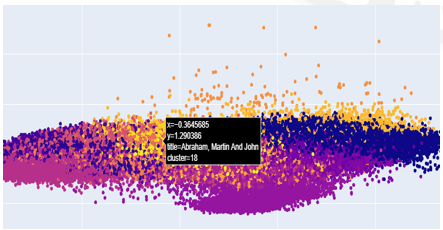Recommendation of Algorithm for Efficient Retrieval of Songs from Musical Dataset
Main Article Content
Abstract
Now-a-days, the research is more towards the entertainment like music, songs, movies, etc. There are many existing works that suggest good songs, movies to people depending on their mood, nature and time that has been savior for the society during the days of lockdown. The existing algorithms used in the literature for basic clustering are K-means, TSNE (T- distributed Stochastic Neighborhood Embedding), PCA (Principal Component Analysis).In this paper, the music dataset considered, consists of songs with attributes as song name, genres, artists, mode, tempo, valence, year, liveness, loudness, popularity, acousticness, danceability, duration, energy, explicit, instrumentalness, key. The important feature is extracted from the other features with the support of literature survey i.e., number of music listeners, types of the songs and type of the music. Later, the dataset is divided into clusters using traditional technique that is k-means based on genre, an important attribute which is selected from the above attributes. The different classifier models like Random Forest, Extra Trees, LightGBM, XGBoost, CatBoost classifier are applied on the clustered dataset and the results have been evaluated on each individual algorithm. Thus the paper recommends not only the group of relevant songs but also suggests the best accurate classification algorithm that can be used for any mentioned musical dataset. The paper also compares all the said ensemble algorithms by calculating the precision, recall, f1-score and support. The accuracy is also calculated for all said ensemble algorithms and based on the accuracy the best suitable algorithm is suggested.
Article Details
References
Lin. L, “Music genre classification using improved random forest algorithm”, Journal of Ambient Intelligence and Humanized Computing, 12(10), 10147-10157, 2021.
Luo. S, “Random Forest-Based Musical Emotion Classification. IEEE Access”, 10, 10759-10769, 2022.
M.S. Rahman, M.S. Islam, M.K. Hasan, and T. Jahan, “Music Genre Classification using Extra Trees Classifier”, In Proceedings of the International Conference on Computer, Communication, Chemical, Materials and Electronic Engineering (IC4ME2-2021), pp. 57-62, 2021.
S.A. Shinde, P.P. Shendge, P.M. Patil, “Music Genre Classification using Ensemble of Extra Trees”, In Proceedings of the 2021 International Conference on Electronics, Information, and Communication (ICEIC), pages 1-5, 2021.
Chen. L, Xie. H, Zhang. Y, & Wang. Z, “ An Ensemble Learning Method for Music Genre Classification Based on LightGBM and Deep Neural Network”, IEEE Access, 9, 18411-18423, 2021.
Liu. Y, Zhao. Y, & Liu. S, “Music genre classification using XGBoost algorithm”, Journal of Physics: Conference Series, 1862(1), 012026, 2021.
Aziz. A, Shahzad. F, Abbas. G, Raza. A, & Alshomrani. S. M, “Music Genre Classification using CatBoost Algorithm”, Journal of Ambient Intelligence and Humanized Computing, 12(8), 8587-8602, 2021.
Kim. S, Kim. S, & Ko. H, “Music Genre Classification Using Convolutional Neural Network and CatBoost”, IEEE Access, 8, 218413-218420, 2020.
Somayeh arefi, mohammed ehsan basari, omid roozmand, “Feature selection for author identification of Persian online short texts”, Journal of information and communication technology”, Issue 47,vol 13,spring-summer 1400 PP:35-57
Mahdiye baharloo, AlirezaYassi, “An improved method for detecting phishing websites using data mining on web pages”, Journal of information and communication technology”, Issue 43 ,vol 12,spring-summer 1399 PP:27-38

